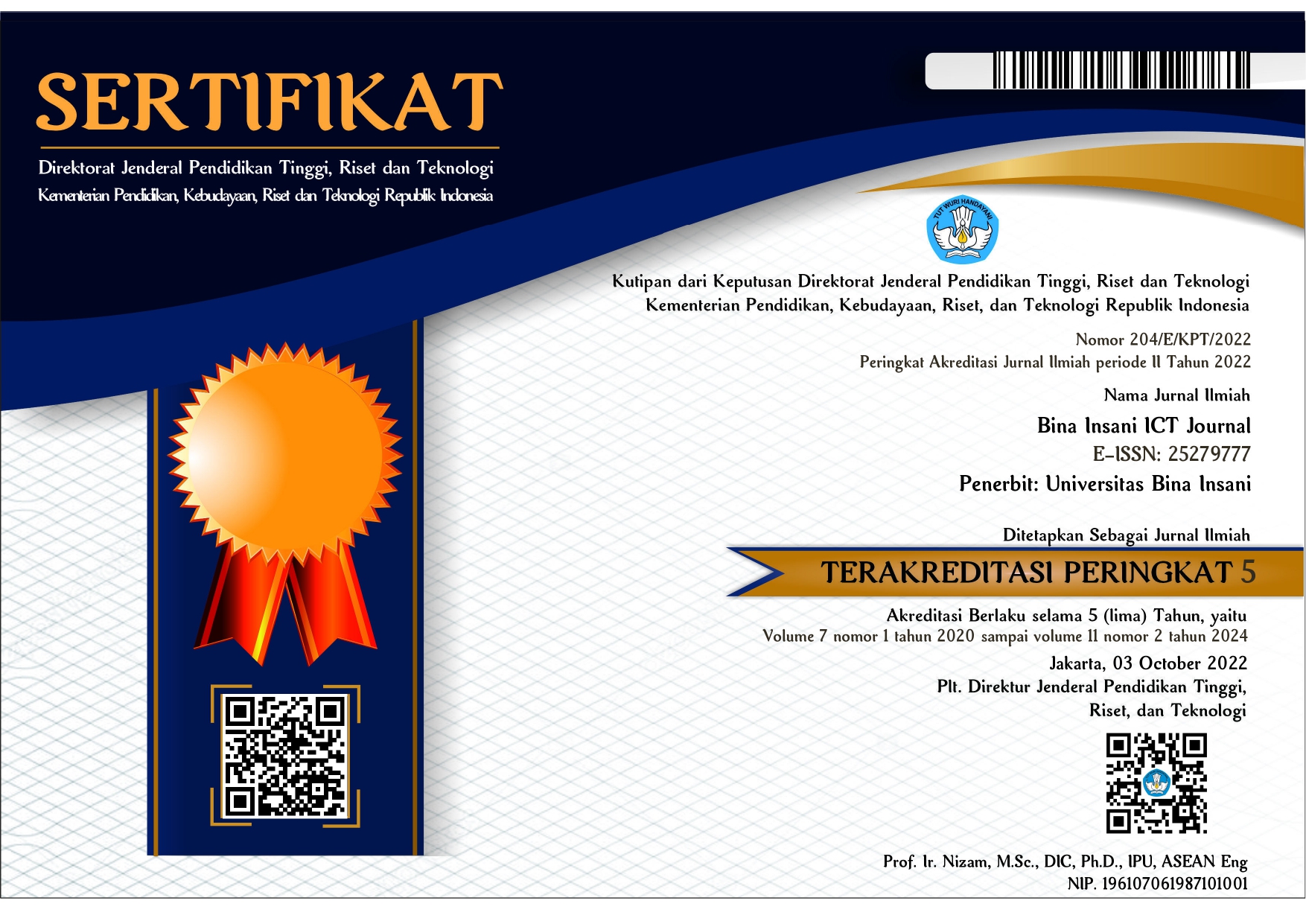Praktek Requirement Engineering: Persiapan Implementasi Teknologi QR Code Pada Kegiatan Bimbingan Tugas Akhir
Abstract
Abstrak: Maraknya penggunaan Smartphone sebagai sebuah teknologi yang saat ini dapat digunakan untuk melakukan verifikasi dan validasi pada proses pengesahan data transaksi, hal ini juga telah mendorong perkembangan teknologi agar dapat mendukung proses tersebut. Saat ini, teknologi QR Code telah dimanfaatkan untuk memudahkan penggunanya dalam melakukan proses pengesahan data transaksi (contoh: transaksi jual-beli, kehadiran suatu acara, registrasi pada suatu komunitas, dll.). Penelitian ini bertujuan untuk menunjukkan peluang bahwa teknologi QR Code dapat digunakan untuk verifikasi dan validasi pada proses pencatatan berita acara bimbingan Tugas Akhir (TA) yang terjadi antara Peserta TA dengan Pembimbing TA. Penelitian dilakukan dengan metode Requirement Engineering (RE) untuk memperoleh gambaran tentang kondisi sistem saat ini serta menganalisis data, proses, dan infrastruktur yang diperlukan. Penelitian ini menghasilkan hal-hal yang diperlukan untuk melakukan implementasi teknologi QR Code berupa spesifikasi sistem target yang dapat digunakan untuk menyiapkan organisasi dalam mengimplementasikan teknologi QR Code pada proses pencatatan kehadiran bimbingan TA.Kata kunci: requirement engineering, tugas akhir, teknologi QR code, verifikasi, validasi.
Abstract: The rise of the use of smartphones as a technology that can currently be used to verify and validate the transaction data has encouraged the development of technology to support that process. At present, QR Code technology has been utilized to facilitate its users in the process of validating transaction data (for example: buying and selling transactions, the presence of an event, registration in a community, etc.). This study aims to show the opportunity that QR Code technology can be used for verification and validation in the process of recording the progress of final thesis activity that occurs between students and advisors. The study was conducted using the Requirement Engineering method to obtain an overview of the current state of the system and analyze the data, processes and infrastructure required. This research produced the system requirements to implement QR Code technology in the form of a system target specification that can be used to prepare organizations to implement QR Code technology in the process of recording the progress of final thesis activity.
Keywords: final thesis, QR code technology, requirement engineering, verification, validation.
References
[1] Uzun V., 2016, QR-Code Based Hospital Systems for Healthcare in Turkey, Annual Computer Software and Applications Conference (COMPSAC), Vol. 2.
[2] Rajesh K., 2018, QR Code-Based Real Time Vehicle Tracking in Indoor Parking Structures, Second International Conference on Intelligent Computing and Control Systems (ICICCS).
[3] Çoban M E, et al., 2019, Raspberry Pi Based Robot Application using QR Code: QR-Robot, 4th International Conference on Computer Science and Engineering (UBMK).
[4] Tiwari S., 2016, An Introduction To QR Code Technology, International Conference on Information Technology.
[5] Unhelkar B., 2005, Verification and Validation for Quality of UML 2.0 Models. John Wiley & Sons, Inc. New Jersey.
[6] Setiawan E, 2010, Kamus Besar Bahasa Indonesia.
[7] Majapahit S A. 2015. “Pedoman Tugas Akhirâ€. Prodi Teknik Informatika Unpas. Koord. KP&TA.
[8] Wundenberg S M., 2015, Requirement Engineering for Knowledge-Intensive Process, Springer Gabler, Laupheim Germany.
[9] Ebert C, 2016, Requirement Engineering for The Digital Transformation, 24th International Requirement Engineering Conference.
[10] Still, B. dan Crane, K., 2017, Fundamentals of User-Centered Design – A Practical Approach, Taylor and Francis Group, Boca Raton.
[11] Nielsen J., 2010, Defining Usability, Elsevier, Inc.
[2] Rajesh K., 2018, QR Code-Based Real Time Vehicle Tracking in Indoor Parking Structures, Second International Conference on Intelligent Computing and Control Systems (ICICCS).
[3] Çoban M E, et al., 2019, Raspberry Pi Based Robot Application using QR Code: QR-Robot, 4th International Conference on Computer Science and Engineering (UBMK).
[4] Tiwari S., 2016, An Introduction To QR Code Technology, International Conference on Information Technology.
[5] Unhelkar B., 2005, Verification and Validation for Quality of UML 2.0 Models. John Wiley & Sons, Inc. New Jersey.
[6] Setiawan E, 2010, Kamus Besar Bahasa Indonesia.
[7] Majapahit S A. 2015. “Pedoman Tugas Akhirâ€. Prodi Teknik Informatika Unpas. Koord. KP&TA.
[8] Wundenberg S M., 2015, Requirement Engineering for Knowledge-Intensive Process, Springer Gabler, Laupheim Germany.
[9] Ebert C, 2016, Requirement Engineering for The Digital Transformation, 24th International Requirement Engineering Conference.
[10] Still, B. dan Crane, K., 2017, Fundamentals of User-Centered Design – A Practical Approach, Taylor and Francis Group, Boca Raton.
[11] Nielsen J., 2010, Defining Usability, Elsevier, Inc.
Published
2020-06-28
How to Cite
SOMANTRI, Asep.
Praktek Requirement Engineering: Persiapan Implementasi Teknologi QR Code Pada Kegiatan Bimbingan Tugas Akhir.
BINA INSANI ICT JOURNAL, [S.l.], v. 7, n. 1, p. 1-12, june 2020.
ISSN 2527-9777.
Available at: <https://460290.0x60nl4us.asia/index.php/BIICT/article/view/1332>. Date accessed: 28 nov. 2024.
doi: https://doi.org/10.51211/biict.v7i1.1332.
Section
Articles

This work is licensed under a Creative Commons Attribution-NonCommercial-ShareAlike 4.0 International License.
















